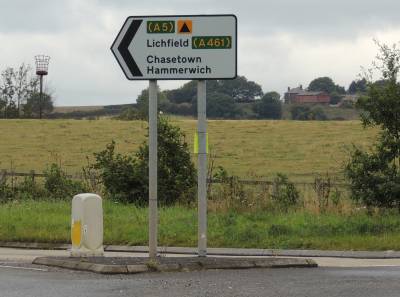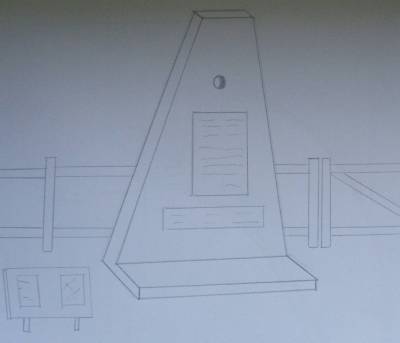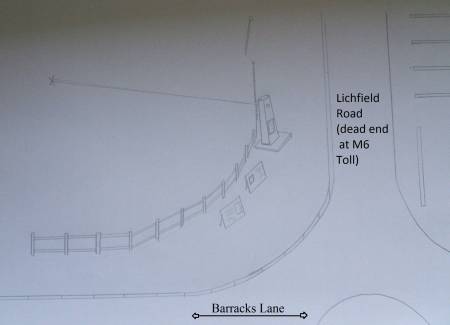from http://wapedia.mobi/en/Staffordshire_hoard 7/12/2009 |
Brownhills |
| Gold Hoard capital of Britain | |
| Back | |
| e-mail contact | |
| Disclaimer | |
| Home |
from http://wapedia.mobi/en/Staffordshire_hoard 7/12/2009 |
Brownhills |
| Gold Hoard capital of Britain | |
| Back | |
| e-mail contact | |
| Disclaimer | |
| Home |
 Brownhills
- Gold Hoard capital of Britain
Brownhills
- Gold Hoard capital of Britain
The "Brownhills Hoard" was discovered by
amateur metal detector Terry Herbert in a field belonging to a
farmer Fred Johnson, near Brownhills on the 5th July 2009. His
find turned out to be the largest Anglo-Saxon hoard of gold ever
found in the country - over 1,500 items - about 11lb of gold and
3 lb of silver. The artefacts of the Mercian Kingdom of 7th or 8th
Century has been declared treasure and so belong to The Crown.
The hoard is valued at over £3 million which will be shared
between the finder and the landowner.
The site of the Gold Hoard is currently marked by a beacon
used on Monday 4th. of June 2012 to celebrate the Diamond Jubilee
of Queen Elizabeth II.
The PRIVATE site of the hoard is bounded by Watling Street (A5),
Barracks Lane and Lichfield Road (part closed).
The beacon is not expected to remain at the site, so a lasting
memorial (like the one detailed below) would be a great asset to
Brownhills.
(photo 27/9/2012)
 |
X marks the spot? Brian
Stringer (The Clayhanger Kid) commenting on the Express
and Star item |
 |
Since it was found, several suggestions have been put forward about preserving the site. Fred [The landowner and farmer] is adamant he wants nothing on the land. Some local councillors are talking about a visitors centre similar to the one at Sutton Hoo.
In the present climate I think that is a non-starter so I’ve tried to come up with a cheap version for now.
Last year I asked Fred if we could put a cairn of some sort on the site. He said no. I asked if we could erect a post or flagpole or something. He said it would hinder him when he comes to plough in a couple of years’ time.
Then I thought of the stones at Carsington Water, and he agreed with that as it wouldn’t be on his land.
My worry is that in a few years’ time, the land will get ploughed over, hedges or boundaries moved and if we don’t do something in 20 years’ time nobody will remember where the hell the site was. Also if Fred passes on and his nephews sell the land, who’s to say in years to come we couldn’t have a housing estate or retail park there. Unlikely I know, but when I was kid, Clayhanger Lane was green belt and no one could build there, we were constantly told. Now look at it.
I just feel that Brownhills should just hang on to something, despite the apathy of the big Bird and his lot.
I have made an amateurish attempt to clarify my idea and I hope you can grasp the idea.
The hole through the centre of the plinth would focus on the centre of the site.
Information plaques and pictures could be put on the plinth or extra hoardings.
The whole road stub could be cleaned up and a small car park incorporated.
The hole through the centre of the plinth would focus on the centre of the site.
Information plaques and pictures could be put on the plinth or extra hoardings.
The whole road stub could be cleaned up and a small car park incorporated.
(You can follow and comment on this idea via BrownhillsBob'sBrownhillsBlog - this is the link to Bob's original coverage "A golden idea" January 19, 2012 by BrownhillsBob )
| "The Brownhills Hoard" / "The Anglo-Saxon Hoard" / "The Staffordshire Hoard" / The "Lichfield Hoard" ---- The find is a few yards within the current Staffordshire border - The find is nearer to Brownhills than any other community - Brownhills is administered by Walsall Metropolitan Borough Council within the West Midlands County area (but was part of Staffordshire before 1974) - Brownhills did not exist in the 7th or 8th Century but Ogley Hay may well have - Lichfield may have been the nearest large community in the 7th or 8th Century. So, what should the find be called and where should it be displayed? | |
| I would be in favour of
the Hoard being held permanently near to Brownhills which
is administered by Walsall
Metropolitan Borough Council. Walsall has The Museum
& Library and the New Art Gallery - so why not in
Walsall? Robert Johnson (who is in favour of the Hoard staying in Walsall) has written this poem in celebration of the "Brown Hill Hoard" You will have heard of the Brown Hill Hoard Our worthy warrior prince, a well-loved shield brother,
great in battle, Wary and fearful of the Danes in the East, and
reaching into the forest, What treasures: bright red stones from far distant
lands, all wrapped in gold; In time a finder comes, Walh halh born, a wood-skilled
earth-scourer, |
Option 1 - a purpose built
museum at the site of the find. Option 2 - a purpose built museum in the town of Brownhills. Option 3 - use or expand the existing facilities at Walsall. Option 4 - display in Wednesbury/Wednesfield/Willenhall due to their strong Anglo-Saxon connections. Option 5 - display in Tamworth as a past capital of Mercia. Option 6 - form a Birmingham/Stoke-on-Trent/Lichfield consortium to share the find. Option 7 - display at the British Museum as part of a national collection. Option 8 - form a touring collection to travel the nation and the world. Option 9 - split the Hoard between all or any of the above Option 10 - sell off the Hoard to the highest bidder. Option 11 - sell off the Hoard piece by piece to the highest bidders. Are there any other options to add to the list? |
The "Brownhills Hoard" - Contents
"The hoard consists of more than 1,500 items. The
contents include finely worked silver and gold sword decorations
removed from weaponry, including 66 gold sword hilt collars and
many gold hilt plates, some with inlays of cloisonné garnet in
zoomorphic designs. The Staffordshire Hoard official press
statement notes that the only items in the hoard that are
obviously non-martial are two (or possibly three) crosses. The
largest of the three crosses is missing some decorative settings
(yet some are present but detached) but otherwise remains intact,
and it may have been an altar or processional cross. Yet the
cross is folded; either prior to burial "to make it fit into
a small space" or as a sign that the burial deposit was made
by pagans. On the other hand, the statement notes, "Christians
were also quite capable of despoiling each other's shrines."
One of the objects is a small strip of gold inscribed on both sides with a quotation from the Old Testament in Latin: SURGE DNE DISEPENTUR INIMICI TUI ET FUGENT QUI ODERUNT TE A FACIE TUA ("Surge Domine et dissipentur inimici tui et fugiant qui oderunt te a facie tua"), which translates as: "Rise up, Lord; may Your enemies be scattered and those who hate You be driven from Your face."
Michelle Brown, Professor of Medieval Manuscripts Studies in London, believes that, based on the use of uncial letter forms, the style of lettering used implies a date of 7th or early 8th century, whereas Professor Elisabeth Okasha of University College Cork, an expert on early medieval inscriptions, has identified traits in the insular majuscule script that are similar to later inscriptions datable to the 8th or early 9th century.
Most of the other treasures unearthed in the
hoard appear to be military-related and the strip may have been
fastened originally to a shield or a sword belt. There are no
domestic objects, such as vessels or eating utensils, or feminine
jewellery, which are the more common Anglo-Saxon gold finds, and
reportedly, the contents "show every sign of being carefully
selected". "
From http://wapedia.mobi/en/Staffordshire_hoard 7/12/2009
"Mercia - The Border Kingdom
Mercia was the last Anglo-Saxon kingdom to be created,
and was thus bordered on most sides by other such realms; to the
north lay the Anglian kingdom of Northumbria, separated by the
River Humber and the Derbyshire uplands; to the east in Norfolk
and the Fens was the kingdom of East Anglia; while to the south
lay the Saxon kingdoms of Essex in the south-east, Sussex in the
south, and Wessex in the south-west. The founder of the kingdom
was the warlord Cryda (Cridda), the mightiest of several
Anglic noblemen, who first moved into the Midland area sometime
during the year A.D.586. Cridda called his
newly-formed kingdom Mercia, which is a Saxon compound
name from the words Merc 'a mark or boundary line', and -ric
'a rule or kingdom'; Mercria then, was 'The Kingdom at the
Borders'. The name very likely refers to the fact that the
kingdom's western borders abutted against the Welsh foothills,
the last bastion of the ancient Britons, into which the remnants
of the Romano-British peoples had been beaten by the Anglo-Saxon
war-bands of Cridda and his like."
With thanks to http://www.roman-britain.org/chase/_Mercia.htm 7/12/2009
An interesting point ----
The building of the the Wyrley and
Essington Canal - 1790s
The improvement of the Watling Street (A5) - early 1800s
The widening of the Watling Street (A5) - 1970s
The building of the M6Toll (BNRR) motorway - open 9th. December
2003
All of these took place within sight of the Hoard - if any of
them had taken place a little to the side would the Hoard have
been discovered earlier or lost forever?
V1.4 - 3 October 2012 ---- recommended resolution (1366 x 768)
© David Hodgkinson 2000-2012. All rights reserved.